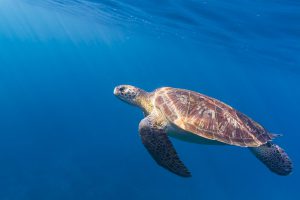Sea turtles are among the most fascinating reptiles in the world. Ecologically speaking, these air-breathing oceanic creatures are extremely successful—virtually unchanged for 120 million years—and have colonized every ocean, outside the poles.
That doesn’t mean, however, they are invincible. Human activities can—and often do—hamper these wonderful animals. But, we can also make a positive difference.
From sea to land and back again
Most reptiles are terrestrial, having evolved from sea dwellers. But, sea turtles are among a few species that returned to the sea, where evolutionary modifications allowed them to thrive.
Over millions of years, their limbs transformed into flippers for better swimming. And, to better glide through the seas, their shells became more streamlined and they shed the ability to retract their head and limbs.

One critical modification came with the development of large lachrymal salt glands, located behind the eyes. These glands—larger even than the animal’s brain—allow turtles to drink saltwater while maintaining the right balance of salt. Excess salt empties into the turtle eyes and, ultimately, back to the sea.
A perilous present
These adaptations helped sea turtles thrive for eons. But, times have changed. Of seven species found globally, including five found in Florida, each now is endangered, in part due to threats caused by human activity.
| Common Name | Scientific Name | Global Conservation Status* | Florida Status ** |
| Leatherback turtle | Dermochelys coriacea | Vulnerable | Endangered |
| Green turtle | Chelonia mydas | Endangered | Endangered |
| Loggerhead turtle | Caretta caretta | Vulnerable | Threatened |
| Hawksbill turtle | Eretmochelys imbricata | Critically endangered | Endangered |
| Kemp’s Ridley turtle | Lepidochelys kempii | Critically endangered | Endangered |
| Olive Ridley turtle | Lepidochelys olivacea | Vulnerable | N/A |
| Flatback turtle | Natator depressus | Data deficient | N/A |
* International Union for Conservation of Nature “Red List of Threatened Species” ** Florida Fish and Wildlife Conservation Commission (FWC)
These threats include:
- bycatch, which is the incidental capture of turtles from commercial fishing for other species,
- illegal trade and direct consumption of turtle meat, eggs, shells, and leather,
- habitat loss due to coastal development, which also destroys or disturbs nesting beaches,
- pollution, which introduces harmful chemicals, and
- climate change, which leads to sea level rise and stronger storms that damage habitat and resources.
A possible future
There is hope, though. Studies have shown turtle populations and nests slowly increasing in some areas as hunting bans, use of fishing gear that minimizes bycatch, protection of nesting beaches, and other conservation efforts have come into play.

Government agencies, academic/research institutions, and non-profit organizations have worked diligently to promote conservation and protect nests. And Floridians have contributed financially to conservation efforts by making the “Helping Sea Turtle Survive” specialty license plate the second-most popular in the state.
One more, simple step people can take is to keep the lights off during sea turtle nesting season, which runs March 1 through Oct. 31 in Florida. Light pollution on nesting beaches alters critical nocturnal behaviors of sea turtles.
Adult female sea turtles only come ashore every 2 to 5 years, to lay eggs. But artificial lightning can keep females from emerging to nest, and make it difficult to find the water after nesting. This reduces the number of nests and increases mortality of adult females, further reducing future nesting.
Nesting itself doesn’t ensure success. Predators dig into nests to eat eggs, or snatch emerging hatchlings before they reach the waves.
Adding to that high hatchling mortality, artificial lighting in developed areas. Hatchlings can orient to these lights and head away from the relative safety of the sea. And, since they emerge from the nests with limited energy, any delay increases the likelihood of dehydration, exhaustion, predation and death.
In Florida, thousands of hatchlings die every year due to this problem.
Low, long and shielded
You can help by following simple recommendations. For exterior lighting:
- Keep It Low. Mount lights low to the ground, and use low-wattage bulbs.
- Keep It Long. Use long-wavelength (560 nm or greater) red or amber LED bulbs.
- Keep It Shielded. Shield fixtures so light is not visible from the beach.
For interior lightning, use blinds, curtains or “turtle tint” on windows to shield lighting. Turtle tint can come pre-applied on glass or applied to windows, reducing by 55 percent or more the amount of light transmitted.
Finally, do not use bright flashlights or camera/cellphone flashes on beaches at night, actions that can scare nesting turtles and are against the law.
Sarasota County has a handy guide for helpful steps you can take: https://www.scgov.net/Home/ShowDocument?id=34304. And the UF/IFAS document library has a great resource with a range of helpful actions: https://edis.ifas.ufl.edu/uw466. Finally, contact UF/IFAS Extension Sarasota County at 941-861-5000 or sarasota@ifas.ufl.edu with any of your questions.
Sea turtles are amazing animals that have survived countless environmental changes across the eons, and we are fortunate to share our planet with them. Let’s do our part to keep them here.
Long, low and shielded keeps the lights off the beach. And, in the turtles’ nesting world, there is no substitute for naturally dark habitats.
 0
0
